
2014-08-14 16:43:21
Experts Talk Eco-Design at Luxe Pack New York
2014-08-14 16:43:21
By Marie Redding, Associate Editor
Experts discussed all things ‘green’ at Luxe Pack New York during the conference, “Luxe in Light of Environmental Responsibility” moderated by Beauty Packaging’s Jamie Matusow.
Conference attendees packed the large room, to see the presentations given by: Dr. Andrew Dent, vice president, library & materials research, Material Connexion; Dan Denisoff, sr. vice president, operations, Pernod Ricard; Stephanie Martins, vice president packaging & development, Americas, L’Oréal; and Henry Renella, sr. vice president, global package development, The Estée
Lauder Companies.
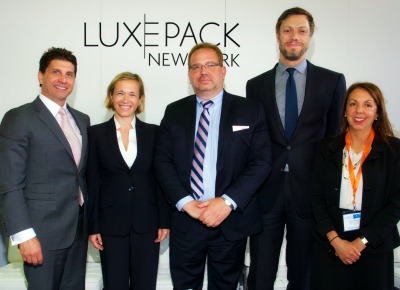
Panelists (L-R) Henry Renella, Stephanie Martins, Dan Denisoff, Dr. Andrew Dent, and Beauty Packaging’s Jamie Matusow.
Martins and Renella are both members of Beauty Packaging’s Board of Advisors.
Delivering ‘Added Value’ & Sustainability
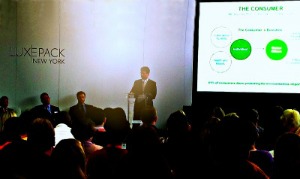 Henry Renella, The Estee Lauder Companies, presenting during the conference. |
Being ‘green’ can pose a unique set of challenges for a luxury brand.
Henry Renella, senior vice president of global package development at The Estée Lauder Companies, explained that consumers are more eco-conscious, but the prestige customer still has certain expectations that need to be met. “We’re here to satisfy consumers – and we have to satisfy all of her expectations,” he said, adding, “…in a luxe market, that’s twice as hard to do.”
Renella pointed out that the consumer’s expectations are higher, in correlation with a product’s price point. This makes it a challenge for a prestige brand is to deliver a luxe package with “added value,” while also meeting a company’s sustainability initiatives.
Dan Denisoff, senior vice president of operations at Pernod Ricard USA said that luxe and eco-design can coexist. He explained how there are many ways for a brand to reduce a package’s material use by applying eco-design principles, while
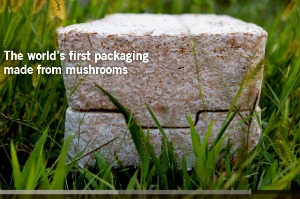 Material Connexion’s Dr. Andrew Dent spoke about new sustainable material options, such as packaging made from mushrooms. |
also delivering the perception of “added value.” One example he showed was how the company was able to redesign the Jameson liquor bottle, and reduce its glass by 30% - perhaps this result will inspire fragrance bottle designers?
Brands Are Delivering Solutions
Despite the challenges, The Estée Lauder Companies was one of the first beauty companies to implement a detailed set of
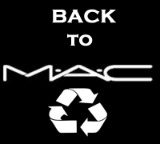 Henry Renella spoke about the brands that are collecting back packaging – like MAC Cosmetics’ Back to MAC program. |
sustainability initiatives, for all of its brands.
Recycling poses additional challenges, for every brand – but especially for cosmetic packaging. Plastic parts must be separated, and many communities don’t have the recycling infrastructure in place to collect the majority of the types of plastic used for beauty products.
Three of The Estée Lauder Companies’ brands are doing their part for the environment by collecting back packaging from consumers for recycling – MAC, Origins and Aveda. L’Oreal’s Garnier is working with Terracycle to sponsor “collection brigades.”
During the conference, Stephanie Martins, vice president of packaging and development, Americas, at L’Oréal, shared information about the company’s “green” mission – and its commitment to make sure the packaging for all of its products will have environmental or social benefits by 2020.
Martins showed a video, which ended with the message: “We’re committed to making beauty sustainable – and together we will make sustainability beautiful.” One of L’Oréal’s “green” goals, according to Martins, includes working with its suppliers to reduce waste in factories, while also developing “sustainability criteria” to rate suppliers.
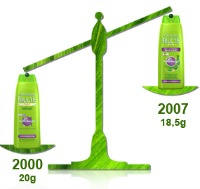 Stephanie Martins spoke about how L’Oreal continues to advance in terms of sustainability, including how Garnier has lightweighted its shampoo bottle. |
Martins also pointed out a few of L’Oréal’s “green” packaging achievements. Garnier has had the lightest shampoo bottle on the market for many years. Kiehl’s has a bottle made from 100% PET; Ralph Lauren has reduced the size of its gift set packaging; and Viktor & Rolf developed a refillable bottle for the fragrance, FlowerBomb.
Future Outlook
Although “green” has its challenges, especially for a luxury brand, it seems as if exciting new developments might soon be influencing package development in a positive way. All of the panelists were optimistic, explaining how it is already becoming less difficult to take a more sustainable path.
Dr. Andrew Dent, vice president of library & materials research at Material Connexion, showed some of the advances in sustainable materials and alternatives to traditional plastics, explaining that the trend is called “The New Naturals.” “We’re using mushrooms to make packaging…we’ve also seen fabrics made from bacteria,” he said.
L’Oréal is taking on the challenge of making sure that the life cycle of every package is improved, for all of its new product launches. “It’s a very ambitious program,” said Martins.
Renella reminded the crowd that it is the beauty industry’s responsibility to be “green,” and manage the stress that producing plastic packaging is putting on the environment and the planet. “We need to be creative, innovative, and use the latest technologies,” said Renella, adding, “I believe that in the near future, no plastics will be made from petroleum. It’s just a matter of time.”
please visit www.topbeautysh.com for more cosmetic packaging information.
LinkedIn




